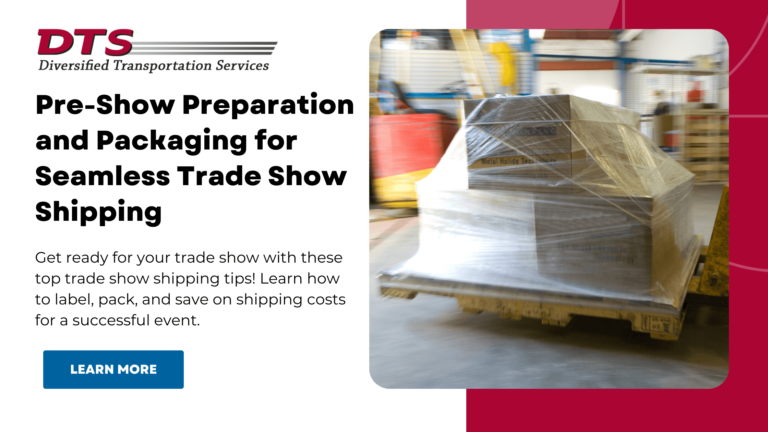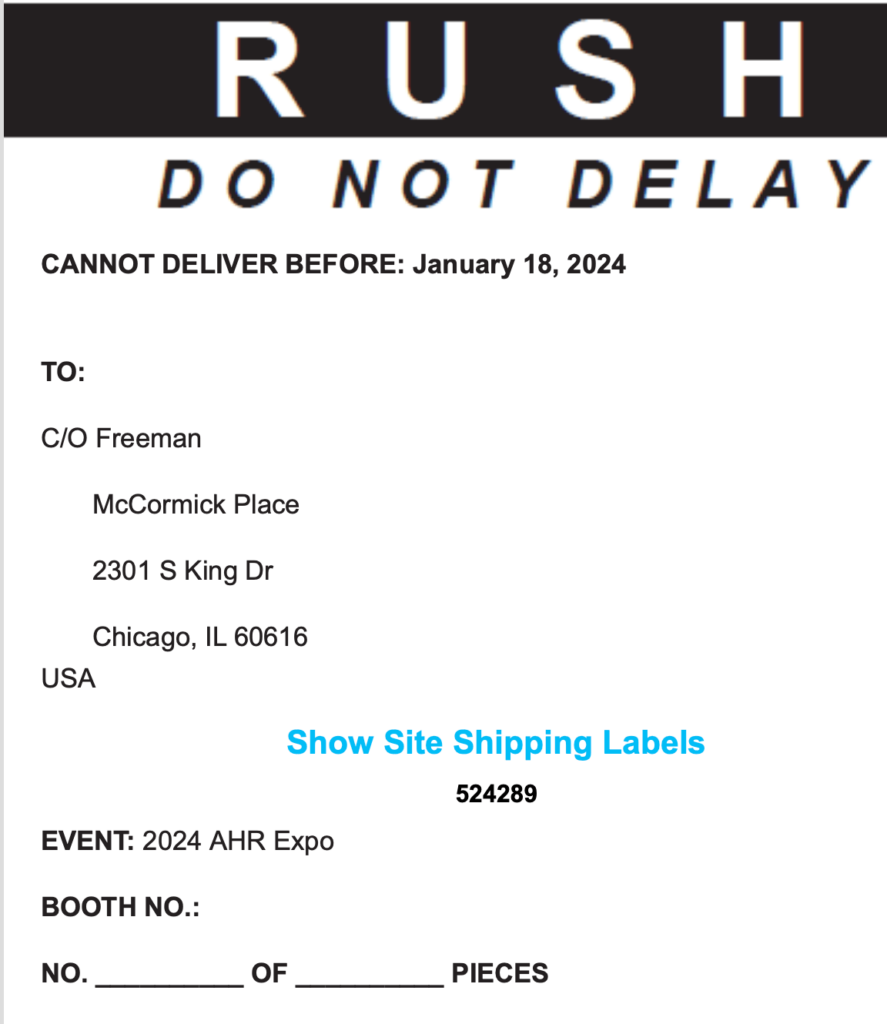
Trade shows are an opportunity to show off what you can do. It’s a rare chance for extravagance as you make your booth as shiny and enticing as possible to attract potential clients. However, getting your materials from the office or warehouse to the trade show creates risk. Things may get damaged or even lost during transportation, so you need to put some thought into trade show shipping.
Getting trade show shipping preparation right can mean the difference between a great trade show and a rough time with beat-up, damaged materials. To prevent this, let’s look at how to prepare for trade show shipping with some top tips.
Each pallet or crate you plan to take will need a clear shipping label. If you plan on shipping your trade show materials in the same packaging they came in, remove all the old shipping labels before affixing new ones. Putting a label on each side of your pallet or crate is always a good practice.
There are many places where you can get your trade show shipping labels:
Show decorators like Freeman, GES, and Shepard often provide trade show shipping labels for their events. You can typically find labels for both advance warehouse shipping and direct-to-show. For example, Freeman offers labels tailored to the AHR Expo. To complete these labels, simply insert your company name, booth number, and the number of pieces you're shipping.

Many trade show shipping companies, like Diversified Transportation Services, provide shipping labels for your trade show shipments, whether they be to the advance warehouse or direct-to-show.
If you prefer to generate your own labels, your show's exhibitor manual will provide guidelines for shipping labels. Note that the advance warehouse and direct-to-show often have different shipping addresses, so ensure you select the correct one. For instance, the AHR Expo provides shipping label instructions on Freeman's Quick Facts page. If your show is managed by Freeman, you can locate this information by searching for your show on this link and navigating to the Quick Facts link.
Standard pallets or plastic crates that have been used repeatedly for trade shows may start to show signs of wear and tear. It's essential to monitor the condition of these shipping materials and replace them when they begin to degrade. This proactive approach is crucial to help ensure the protection of your exhibit materials and company merchandise during transportation to and from trade shows.
The trade show will be inundated with crates from all the exhibitors attending. Venue staff will need to know which crates belong to you to avoid them being misplaced or left at the wrong booth, especially when the show decorator stores your crates after you have unpacked them.
Marking your crates with company branding is a simple way to identify your materials. It ensures venue staff knows who the crates belong to and boosts brand awareness. It also means your booth will look better if you need to bring any crates onto the exhibition floor.
The exhibitor manual is an essential document you should be familiar with before shipping anything. Have all the key information ready to help ensure all your materials end up where they need to be. You’ll need to add information about the show to the bill of lading, including the booth number, show name, and company name on all shipping labels. A good practice is to add your target move-in date to your BOL and labels to help ensure the freight carrier is aware of when your freight needs to be delivered.
Trade shows and conventions will often have different guidelines when it comes to shipments. Some may give you the option to ship to the advance warehouse before the event. Others will ask you to ship directly to the venue. You need to familiarize yourself with these guidelines to ensure you’re sending everything to the right place with plenty of time.
Not everything you take to a trade show needs to be shipped with your freight carrier. You can cut down on your shipping costs by thinking smarter. You can bring smaller items, like boxes of pens, with you.
Also, consider your exhibition booth. You can save a lot of money by using interlocking carpet panels for your booth, rather than renting and shipping a full carpet. These can also be reused for future shows, saving you more in the long run. Looking for these smart swaps can make your trade show shipping experience easier and more efficient.
**Pro Tip when Shipping to Trade Show**
When dealing with small parcel shipments that need to be sent separately after your initial materials have been shipped, consider sending them directly to your hotel. You can then personally bring these items into the show.
It's worth noting that certain show decorators may impose material handling fees, even for small boxes that are delivered to your booth. By sidestepping this cost, you can potentially save on your trade show expenses.
It’s very likely that you’ll forget something seemingly innocuous that turns out to be important once you arrive at the trade show. Consider making a checklist for small items that you might need to take with you, including:
Timing your trade show shipping right can help reduce the cost. The more time you can give your trade show shipping company, the cheaper your shipment will be. While choosing a last-minute priority shipment may be tempting, this comes at a premium. It’s better to plan your shipment, prepare everything early, and ship with plenty of time to arrive on schedule.
Choosing a partner that understands the nuances of trade show shipping and makes the process simple. DTS has a well-developed network of knowledgeable and reliable freight carriers specializing in trade show exhibits. DTS makes trade show shipping a breeze, which means less stress for you.
Contact us today for more information about our trade show shipping services.
Whether you're a company looking to improve one facet of your supply chain, your entire supply chain, or simply looking for a transportation and logistics consultation, we can help.